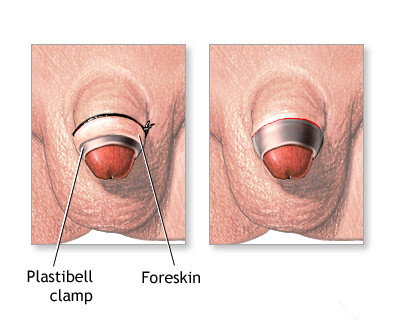Circumcision is the surgical removal of the skin that covers the tip of the penis, which is usually performed on newborn babies within the first two days of being born and before they leave the hospital. In the Hebrew faith, the circumcision is often performed eight days after birth with a special ceremony. This procedure is not required medically, although some research has shown that it reduces the risk of developing certain health implications in the future. There are numerous methods of circumcision, and the most common ones are the Mogen clamp, the Gamco clamp and the Plastibell technique. Plastibell Circumcision is the method that will be discussed in this article, detailing the procedure, as well as Plastibell circumcision healing.
Plastibell Circumcision Procedure
 The Plastibell circumcision device has a clear, rounded plastic ring with a handle, and has a deep indentation which runs circumferentially. Before the Plastibell is used, the foreskin will be cut with a hemostat, separating the foreskin from the glans. The foreskin is then slit horizontally with the surgical device in order to expose the head of the penis. With numerous sizes of the Plastibell, the appropriate size is chosen and applied onto the head of the penis. The foreskin is then put around the ring, and tied tightly with a ligature, which pushes the foreskin against the indentation in the device. The surplus skin around the ring is then surgically removed, and the handle is broken off, leaving the ring in place.
The Plastibell circumcision device has a clear, rounded plastic ring with a handle, and has a deep indentation which runs circumferentially. Before the Plastibell is used, the foreskin will be cut with a hemostat, separating the foreskin from the glans. The foreskin is then slit horizontally with the surgical device in order to expose the head of the penis. With numerous sizes of the Plastibell, the appropriate size is chosen and applied onto the head of the penis. The foreskin is then put around the ring, and tied tightly with a ligature, which pushes the foreskin against the indentation in the device. The surplus skin around the ring is then surgically removed, and the handle is broken off, leaving the ring in place.
The procedure takes, on average, around 5 to 10 minutes to complete. This can vary depending on who is performing the operation, as well as other factors. The plastic ring will usually fall off in around 3 to 7 days, but whilst attached, it causes necrosis of the foreskin tissue. Once the ring has detached, there will often be a slight wound at the area, which will typically be red or yellow in color, and often healing within a week. This method of circumcision is non-scalpel, meaning there is no requirement to actually slice the foreskin and its remnants off.
Care for the Plastibell Circumcision Healing
To ensure a full recovery from the circumcision, you can take some measures and cares for your baby.
1. Wound Care
Normal washing and bathing should still be carried out with your child. Some lubricants, such as antibiotic ointment, can be applied to help avoid the wound contacting directly with materials, such as their diaper.
2. Pain Relievers
This will often not be needed, and is perhaps best avoided with newborn children. Older children who have undergone the procedure may be given pain killers, such as Paracetamol. Just ensure to read the label first and do not give them too much.
3. Complications
It will take about 7 days to complete the Plastibell circumcision healing. However, some complications may arise during the process, which include:
- Bleeding, which is rare due to the method of circumcision
- Infection, which can be avoided if the procedure is practiced hygienically.
Some complications require you take your baby back to the hospital for check quickly, including:
- The child is painful or distressed
- Unusual swelling
- Urination difficulties
- Fever
- The plastic ring slides out of position and is down the shaft
- The plastic ring has not fallen off on its own after numerous days
Care for a Circumcised Penis for the First Few Years
When caring for your child after circumcision, it is important to regularly clean the area of the penis properly. The cells that have undergone necrosis (died), may grow back regularly. If accumulation of these cells occurs, a white substance known as smegma may begin to form. The formation of this substance is entirely normal, and it is possible to become trapped if any adhesions between the glans and foreskin form (penile adhesion). This usually requires no medical intervention, unless they become inflamed or red in color.
As your boy grows and his body develops, he will begin to build up body fat. This can cause the development of a fat pad (tightly packed cells of fat) at the penis's base. This should be pushed down whilst cleaning the penis.If you notice that the skin of the penis seams to stick to the penis's head, it is advised to use some lubrication to avoid any further adhesions. As soon as your son reaches an appropriate age, teach them the proper way and importance to clean and bathe the penis, so they can do it autonomously.
